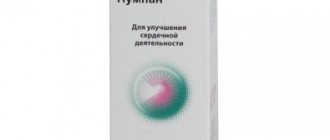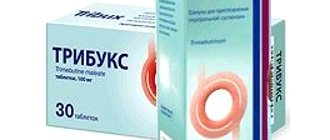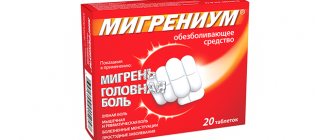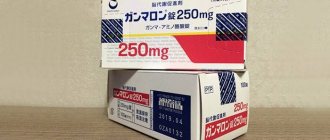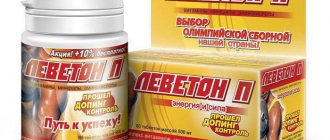Instructions for use AnGriMax (ANGRIMAX)
Antiviral drug of combined composition. The pharmacological activity of the drug AnGriMax is due to the complex action of its components —
paracetamol, rimantadine, ascorbic acid, loratadine, rutin and calcium.
The drug has antiviral, interferonogenic, antipyretic, anti-inflammatory, analgesic, antihistamine, and angioprotective effects.
Paracetamol
has antipyretic, analgesic and some anti-inflammatory effects, reduces the pain syndrome observed with colds, sore throat, headache, muscle and joint pain, reduces elevated body temperature. Blocks the enzymes COX-1 and COX-2 mainly in the central nervous system. Due to the lack of a blocking effect on the synthesis of prostaglandins in peripheral tissues, it does not affect water-salt metabolism (retention of sodium and water ions) and the gastrointestinal mucosa.
Rimantadine
- antiviral agent, adamantane derivative. Active against various strains of influenza A virus, Herpes simplex viruses type 1 and 2, tick-borne encephalitis viruses (Central European and Russian spring-summer from the group of arboviruses of the Flaviviridae family). Has antitoxic and immunomodulatory effects. Suppresses the early stage of specific reproduction (after the virus enters the cell and before the initial transcription of RNA); induces the production of alpha and gamma interferons, increases the functional activity of lymphocytes - natural killer (NK) cells, T- and B-lymphocytes. Being a weak base, it increases the pH of endosomes that have a vacuole membrane and surround viral particles after they penetrate the cell. Preventing acidification in these vacuoles blocks the fusion of the viral envelope with the endosome membrane, thereby preventing the transfer of viral genetic material into the cell cytoplasm. Rimantadine also inhibits the release of viral particles from the cell, i.e. interrupts transcription of the viral genome.
Ascorbic acid
participates in the regulation of redox processes, carbohydrate metabolism, blood clotting, tissue regeneration, and reduces vascular permeability. It has antiplatelet and pronounced antioxidant properties. Maintains the colloidal state of the intercellular substance and normal capillary permeability (inhibits hyaluronidase). Due to the activation of respiratory enzymes in the liver, it enhances its detoxification and protein-forming functions, and increases the synthesis of prothrombin. Regulates immunological reactions (activates the synthesis of antibodies, C3 component of complement, interferon), promotes phagocytosis, increases the body's resistance to infections. Inhibits the release and accelerates the degradation of histamine, inhibits the synthesis of prostaglandins and other mediators of inflammation and allergic reactions.
Loratadine
- a highly active long-acting blocker of histamine H1 receptors. Suppresses the release of histamine and leukotriene C4 from mast cells. It has antiallergic, antipruritic, antiexudative effects. Reduces capillary permeability, prevents the development of tissue edema, relieves spasms of smooth muscles.
Calcium carbonate
prevents the development of increased permeability and fragility of blood vessels, promotes normal blood clotting, participates in the transmission of nerve impulses, contractions of skeletal and smooth muscles, and in the regulation of cardiac activity.
Rutin
is an angioprotector. Prevents the development of increased permeability and fragility of blood vessels, which cause hemorrhagic processes during influenza, and also restores capillary circulation. Rutin, together with ascorbic acid, participates in redox processes, has antioxidant properties, prevents oxidation and promotes the deposition of ascorbic acid in tissues. Both components strengthen the vascular wall (promote the formation of intercellular substance and reduce the activity of hyaluronidase), reduce the permeability and fragility of capillaries.
AnGriMax capsules No. 10x2
Name
AnGreeMax
Description
Hard gelatin capsules No. 0, cylindrical in shape with hemispherical ends, yellow body and green cap.
Main active ingredient
Paracetamol+rimantadine+ascorbic acid+loratadine+rutoside+calcium carbonate
Release form
Capsules
Dosage
20 pcs.
Indications for use
Etiotropic and symptomatic treatment of influenza, ARVI, febrile conditions due to viral damage to the respiratory tract in adults and children over 12 years of age.
Directions for use and doses
Inside, after meals, with water. Children over 12 years of age and adults - 2 capsules 2-3 times a day for 3-5 days while the febrile syndrome persists. If you do not feel better while taking the drug, you should stop and consult a doctor!
Use during pregnancy and lactation
Teratogenic effects: Pregnancy - category C. There are no adequate and controlled studies in pregnant women. Remantadine has been reported to cross the placenta in mice. Remantadine is embryotoxic in rats when administered at a dose of 200 mg/kg/day (11 times the MRHD on a mg/m2 basis). At this dose, embryotoxic effects consisted of an increase in fetal resorption in rats, and this dose also caused a variety of maternal effects, including ataxia, tremors, seizures, and significant weight loss. No embryotoxicity was observed when rabbits received doses up to 50 mg/kg/day (approximately 0.1 times the MRHD based on AUC), but evidence of developmental abnormalities was noted in the form of changes in the proportion of fetuses with 12 or 13 ribs. This ratio is usually about 50:50 in a litter, but after treatment with rimantadine it is 80:20. Non-teratogenic effects: Remantadine was administered to pregnant rats pre- and postpartum at doses of 30, 60 and 120 mg/kg/day (1.7, 3.4 and 6.8 times the MRHD on a mg/m2 basis). Maternal toxicity during pregnancy was noted at the two higher doses of rimantadine, and at the maximum dose of 120 mg/kg/day, there was an increase in mortality in the first 2–4 days postpartum. Reduced fertility of the F1 generation was also noted for the two higher doses. For these reasons, the drug is contraindicated during pregnancy. Nursing Mothers: Remantadine is contraindicated in nursing mothers due to adverse effects observed in the offspring of rats treated with rimantadine during the nursing period. Remantadine was detected in the milk of rats in a dose-dependent manner: from 2 to 3 hours after administration.
Precautionary measures
Interaction with other drugs
If you need to take it together with other medications, consult your doctor first. The combined use of paracetamol and rimantadine leads to a decrease in the maximum concentration and AQC of rimantadine by approximately 11%. Ascorbic acid reduces the Cmax of rimantadine by 10%. Cimetidine reduces the clearance of rimantadine by 18%. Remantadine reduces the effectiveness of antiepileptic drugs. Paracetamol reduces the effectiveness of uricosuric drugs. Inducers of microsomal oxidation in the liver (phenytoin, ethanol, barbiturates, rifampicin, phenylbutazone, tricyclic antidepressants), ethanol and hepatotoxic drugs increase the production of hydroxylated active metabolites, which makes it possible to develop severe intoxications even with a slight overdose. Long-term use of barbiturates reduces the effectiveness of paracetamol. Ethanol contributes to the development of acute pancreatitis. Inhibitors of microsomal oxidation (including cimetidine) reduce the risk of hepatotoxicity. Long-term combined use of paracetamol and other NSAIDs increases the risk of developing “analgesic” nephropathy and renal papillary necrosis, and the onset of end-stage renal failure. Diflunisal increases the plasma concentration of paracetamol by 50% - the risk of developing hepatotoxicity. Myelotoxic drugs increase the manifestations of hematotoxicity of the drug. Ascorbic acid increases the concentration of benzylpenicillin and tetracyclines in the blood; at a dose of 1 g/day increases the bioavailability of ethinyl estradiol (including that included in oral contraceptives). Reduces the effectiveness of heparin and indirect anticoagulants. Increases the risk of developing crystalluria during treatment with salicylates and short-acting sulfonamides, slows down the excretion of acids by the kidneys, increases the excretion of drugs that have an alkaline reaction (including alkaloids). Increases the overall clearance of ethanol, which in turn reduces the concentration of ascorbic acid in the body. When used simultaneously, it reduces the chronotropic effect of isoprenaline. Barbiturates and primidone increase the excretion of ascorbic acid in the urine. Reduces the therapeutic effect of neuroleptics - phenothiazine derivatives, tubular resorption of amphetamine and tricyclic antidepressants. CYP3A4 inhibitors (including ketoconazole, erythromycin), CYP3A4 and CYP2D6 inhibitors (cimetidine, etc.) increase the concentration of loratadine in the blood. Inducers of microsomal oxidation (phenytoin, ethanol, barbiturates, rifampicin, phenylbutazone, tricyclic antidepressants) reduce the effectiveness of loratadine.
Contraindications
hypersensitivity to one or more components included in the drug; pregnancy and lactation; children up to 12 years of age.
Compound
One capsule contains: paracetamol - 180 mg, rimantadine hydrochloride - 25 mg, ascorbic acid (in the form of SC-coated ascorbic acid) - 150 mg, loratadine - 1.5 mg, rutin - 10 mg, calcium (in the form of calcium carbonate) - 4.45 mg.
Overdose
Symptoms: in the first 24 hours, pallor, nausea, vomiting and pain in the epigastric region, tremor, drowsiness, tachycardia, increased bilirubin in the blood, metabolic disorders, exacerbation of concomitant chronic diseases are possible. Treatment: induce a gag reflex, gastric lavage, taking adsorbents, symptomatic therapy. You need to see a doctor.
Side effect
From the side of the central nervous system: Rarely - headache, increased fatigue, increased excitability, dizziness, tremor, hyperkinesia. From the gastrointestinal tract If taken for more than 7 days, damage to the mucous membrane of the stomach and duodenum, dyspepsia, dry mouth, nausea, anorexia, flatulence, and diarrhea are possible. From the blood system When taken for more than 7 days - agranulocytosis, leukopenia, thrombocytopenia, neutropenia, anemia. Allergic reactions Rare - possible skin rash, itching, urticaria.
Storage conditions
Store in a place protected from moisture and light at a temperature of 15°C to 25°C. Store out of the reach of children.
Buy AnGriMax caps. in container pack No. 10x2 in the pharmacy
Price for AnGriMax caps. in container pack No. 10x2
Instructions for use for AnGriMax caps. in a container pack No. 10x2
"Angrimax Neo". Better without flu and colds!
18.10.2018
"Angrimax Neo". Better without flu and colds!
Fever, nasal congestion, headache - these manifestations of a cold have more than once disrupted the usual course of our lives.
And every year, with the onset of cold weather, acute respiratory infections are on the doorstep again... Cold weather itself does not cause a cold, but it creates favorable conditions for the development of viruses, many of which are better preserved at low temperatures and high humidity. Therefore, the so-called “cold season” occurs during the cold season – autumn and winter.
To prevent the cold season from becoming another test for immunity, do not forget about preventive measures. Try to spend less time in crowded places and avoid contact with people showing signs of a cold. Regularly ventilate the room, do not forget about hand hygiene and do not touch your mouth and nose again: viruses can enter the body through your hands when coming into contact with an infected surface. A healthy lifestyle - getting enough sleep, a balanced diet, physical activity and regular walks in the fresh air - will strengthen your body and help you stay healthy longer.
If prevention turns out to be ineffective, the combination drug AnGriMax NEO helps resist acute respiratory infections. Thanks to its complex composition, AnGriMax NEO helps eliminate the symptoms of colds and rhinitis. Part of the combination of active ingredients, paracetamol has an antipyretic, anti-inflammatory and analgesic effect, phenylephrine hydrochloride helps reduce swelling of the mucous membranes of the nose and sinuses, and the antihistamine pheniramine reduces nasal discharge.
AnGriMax NEO is used in adults and children aged 15 years and older for the treatment of colds, rhinitis, nasopharyngitis and influenza-like conditions, accompanied by a runny nose and lacrimation, sneezing, headache and fever. The high quality of production of the drug AnGriMax NEO is ensured by the presence of the national GMP (Good Manufacturing Practice) certificate at Minskintercaps.
AnGriMax NEO - better without flu and colds!
If the febrile syndrome continues for more than 3 days during the use of drugs and the pain syndrome continues for more than 5 days, you should consult a doctor
There are medical contraindications and side effects. Contraindicated during pregnancy
BEFORE USE, READ THE INSTRUCTIONS
Products on the topic: AnGriMax - a cure for the flu
Instructions for use
According to the instructions for use, Angrimaks is taken orally, after meals, with water.
Children over 12 years of age and adults – 2 capsules 2-3 times a day for 3-5 days while the febrile syndrome persists.
If you do not feel better while taking the drug, you should stop and consult a doctor!
special instructions
Treatment should begin no later than 48 hours from the appearance of the first symptoms of the disease.
Duration of use - no more than 5 days, according to Angrimax instructions. With long-term use (more than 7 days), exacerbation of chronic concomitant diseases is possible; in elderly patients with arterial hypertension, the risk of developing hemorrhagic stroke increases (due to the rimantadine included in the drug).
To develop post-infectious immunity, it is not recommended for use in children under 12 years of age.
If there is a history of epilepsy and ongoing anticonvulsant therapy while using rimantadine, the risk of developing an epileptic seizure increases.
When taken, the risk of developing liver damage increases in patients with alcoholic hepatosis. Distorts laboratory test results in the quantitative determination of glucose and uric acid in plasma (paracetamol).
Due to the stimulating effect of ascorbic acid on the synthesis of corticosteroid hormones, it is necessary to monitor adrenal function and blood pressure. Ascorbic acid as a reducing agent can distort the results of various laboratory tests (blood glucose, bilirubin, liver transaminase and LDH activity).
Do not use in the presence of metastatic tumors.
The risk of paracetamol overdose is higher in patients with alcoholic liver disease without cirrhosis. It is necessary to seek immediate medical attention in case of overdose, even if the patient feels well, due to the risk of delay and subsequent serious liver damage.
Adverse effects can be minimized by using the lowest effective dose for the shortest duration necessary to control symptoms and by taking doses with food.
To avoid possible damaging effects on the liver, you should not drink alcohol while taking Angrimax according to the instructions for use.
Pregnancy and breastfeeding period
Teratogenic effects of the drug Angrimax: Pregnancy - category C. There are no adequate and controlled studies in pregnant women. Remantadine has been reported to cross the placenta in mice. Remantadine is embryotoxic in rats when administered at a dose of 200 mg/kg/day (11 times the MRHD on a mg/m2 basis). At this dose, embryotoxic effects consisted of an increase in fetal resorption in rats, and this dose also caused a variety of maternal effects, including ataxia, tremors, seizures, and significant weight loss. No embryotoxicity was observed when rabbits received doses up to 50 mg/kg/day (approximately 0.1 times the MRHD based on AUC), but evidence of developmental abnormalities was noted in the form of changes in the proportion of fetuses with 12 or 13 ribs. This ratio is usually about 50:50 in a litter, but after treatment with rimantadine it is 80:20.
Non-teratogenic effects of Angrimax: Remantadine was administered to pregnant rats in the pre- and postpartum period at doses of 30, 60 and 120 mg/kg/day (1.7, 3.4 and 6.8 times the MRHD on a mg/m2 basis). Maternal toxicity during pregnancy was noted at the two higher doses of rimantadine, and at the maximum dose of 120 mg/kg/day, there was an increase in mortality in the first 2–4 days postpartum. Reduced fertility of the F1 generation was also noted for the two higher doses.
According to the instructions for use of Angrimax, for these reasons, the drug is contraindicated during pregnancy.
Nursing Mothers: Remantadine is contraindicated in nursing mothers due to adverse effects observed in the offspring of rats treated with rimantadine during the nursing period.
Remantadine was detected in the milk of rats in a dose-dependent manner: from 2 to 3 hours after administration.
Impact on the ability to drive a car, work with equipment
Patients should refrain from activities that require increased attention, rapid mental and motor reactions (the drug contains rimantadine).
Interaction with other drugs
If you need to take it together with other medications, consult your doctor first.
The combined use of paracetamol and rimantadine leads to a decrease in the maximum concentration and AUC of rimantadine by approximately 11%. Ascorbic acid reduces the Cmax of rimantadine by 10%. Cimetidine reduces the clearance of rimantadine by 18%.
Remantadine reduces the effectiveness of antiepileptic drugs.
Paracetamol reduces the effectiveness of uricosuric drugs. Inducers of microsomal oxidation in the liver (phenytoin, ethanol, barbiturates, rifampicin, phenylbutazone, tricyclic antidepressants), ethanol and hepatotoxic drugs increase the production of hydroxylated active metabolites, which makes it possible to develop severe intoxications even with a slight overdose. Long-term use of barbiturates reduces the effectiveness of paracetamol. Ethanol contributes to the development of acute pancreatitis. Inhibitors of microsomal oxidation (including cimetidine) reduce the risk of hepatotoxicity. Long-term combined use of paracetamol and other NSAIDs increases the risk of developing “analgesic” nephropathy and renal papillary necrosis, and the onset of end-stage renal failure. Diflunisal increases the plasma concentration of paracetamol by 50% - the risk of developing hepatotoxicity. Myelotoxic drugs increase the manifestations of hematotoxicity of the drug.
Ascorbic acid increases the concentration of benzylpenicillin and tetracyclines in the blood; at a dose of 1 g/day increases the bioavailability of ethinyl estradiol (including that included in oral contraceptives). Reduces the effectiveness of heparin and indirect anticoagulants. Increases the risk of developing crystalluria during treatment with salicylates and short-acting sulfonamides, slows down the excretion of acids by the kidneys, increases the excretion of drugs that have an alkaline reaction (including alkaloids). Increases the overall clearance of ethanol, which in turn reduces the concentration of ascorbic acid in the body. When used simultaneously, it reduces the chronotropic effect of isoprenaline. Barbiturates and primidone increase the excretion of ascorbic acid in the urine. Reduces the therapeutic effect of neuroleptics - phenothiazine derivatives, tubular resorption of amphetamine and tricyclic antidepressants.
CYP3A4 inhibitors (including ketoconazole, erythromycin), CYP3A4 and CYP2D6 inhibitors (cimetidine, etc.) increase the concentration of loratadine in the blood. Inducers of microsomal oxidation (phenytoin, ethanol, barbiturates, rifampicin, phenylbutazone, tricyclic antidepressants) reduce the effectiveness of loratadine.
Side effect
From the side of the central nervous system: rarely - headache, increased fatigue, increased excitability, dizziness, tremor, hyperkinesia.
From the gastrointestinal tract: if taken for more than 7 days, damage to the mucous membrane of the stomach and duodenum, dyspepsia, dry mouth, nausea, anorexia, flatulence, diarrhea are possible.
From the blood system: when taken for more than 7 days - agranulocytosis, leukopenia, thrombocytopenia, neutropenia, anemia.
Allergic reactions: rarely - possible skin rash, itching, urticaria.
Overdose
Symptoms: in the first 24 hours, pallor, nausea, vomiting and pain in the epigastric region, tremor, drowsiness, tachycardia, increased bilirubin in the blood, metabolic disorders, exacerbation of concomitant chronic diseases are possible.
Signs of an overdose of paracetamol are nausea, vomiting, stomach pain, pale skin, anorexia. After a day or two, signs of liver damage are detected. In severe cases, liver failure and coma develop. The toxic effect of paracetamol in adults is possible after taking more than 10-15 g of paracetamol: increased activity of “liver” transaminases, increased prothrombin time (12-48 hours after administration); a detailed clinical picture of liver damage appears after 1-6 days. Rarely, liver damage develops at lightning speed and can be complicated by renal failure (tubular necrosis).
Treatment: if you suspect an overdose, consult a doctor. The victim should undergo gastric lavage during the first 4 hours of poisoning and take adsorbents (activated carbon). Administration of SH-group donors and precursors of glutathione synthesis - methionine - 8-9 hours after an overdose and N-acetylcysteine - after 12 hours. the need for additional therapeutic measures is determined depending on the concentration of paracetamol in the blood, as well as the time elapsed after its administration.
»

